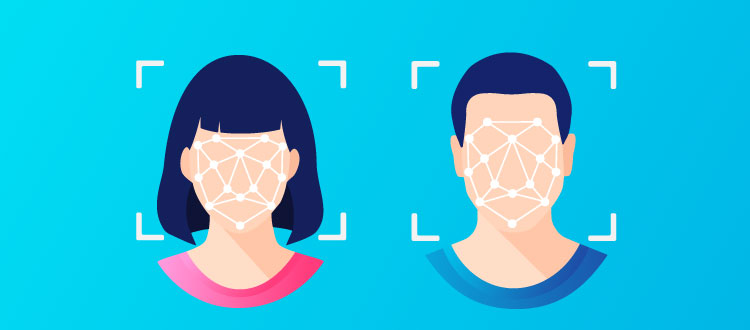September 22, 2021 || Reading Time: 8 minutes || Facial scanning seemed like a fantasy a few years ago, but today we can open our mobile phones by scanning our faces.

Millions of people are happy to access their smartphones with facial scanning worldwide. Facial scanning technology has a rapid increase in corporate organizations, airports, mobile phones, and shopping malls. Although facial recognition has advantages to companies, biometric technology also poses threats that both companies and users are concerned about in recent years. Although many automobile companies still introduce facial scanning technology.
Technological developments continue to open new ways in which organizations can use face template data to improve their efficiency and reliability. It is common to unlock a smartphone with facial scanning or check-in at the airport with your face today. Although the technology for facial scanning has brought countless advantages, its use also carries substantial privacy risks. This article talks about facial scanning technology, threats that evolved in it, and how to mitigate them.
What Is Facial Scanning Technology?
Facial scanning is a new age technology computerized to match a human face among a huge record of images or videos of faces in a database called a facial recognition database. The primary purpose of facial scanning is to authorize users against identity verification services by mapping out the features of a facial structure and distinctive details such as distance between eyes, the shape of the nose, etc., from an array of provided images or videos.
The technology of facial scanning attracts a lot of attention. Many companies and organizations use online recognition and verification to achieve their desired objectives, whether for fun, security, or user experience. Facial scanning is a biometric check that can identify or verify an individual to compare and analyze patterns based on the person’s facial contours.
Facial recognition uses deep learning algorithms to make it more likely to have fewer errors compared. Deep learning is a form of machine learning that provides data to learn from artificial neural webs, human-inspired algorithms. A deep learning algorithm would repeat a task, modifying it each time to improve the outcome. It identifies and captures the human face and then becomes an object of verification based on the essential characteristics of the face. These characteristics are generally the position of the eyes, the nose, and the corners of the mouth.
- For instance, facial scanning firstly scans the distance between your eyes, nose, and mouth, the shape of your nose and mouth, and a variety of all other minor details on the face.
- Once all features on your face are identified, a face signature will be created. Finally, once the face is scanned, a database with known faces is compared for a match again.
How does Facial Scanning Technology Work?
Humans can identify faces quickly. You will likely find the facet of an individual, a friend, or an acquaintance in your family. Your face features — the distance between the arch of your eyebrows and eyes, the tilt of your lips, position of your nose, etc. comprise your unique facial structure; this is how it works but on a large, algorithmic scale. Recognition technology sees data where you see a face. This information can be saved and accessed.
Face detection
Firstly, facial scanning begins with a face and identifies the appropriate face characteristics of the person. We think the human face is a basic set of eyes, nose, and mouth characteristics. Like that, the facial scanning technology recognizes the face; this is done through an extensive database of images with human sides looking at different points of view with deeper neural network & machine learning algorithms.
It starts with eyes, then eyebrows followed by nose and mouth begins to calculate the nose width, distance from forehead to mouth, and sizes. Once all the features are identified on the face region, the algorithm’s numerous algorithm training is performed on databases to detect faces.
· Face recognition
After the face is identified, a program is designed to detect the facial landmarks with an image processing algorithm. Each landmark on the face is referred to as nodal points about 80 on every human face. These landmarks are very crucial in identifying the face in the database. Now the face registered in the database is repositioned and appropriately scaled to match the original face as it is beneficial to recognize when the facial expressions change.
· Face representation
After the face is registered, the face’s nodal points, position, and sizes are sent into the software. Later, the software assigns a new face vector for every individual face in numerical codes called faceprints. Now, each faceprint distinguishes from person to person in the database.
Face matching
Lastly, after the face is recognized with the new vector code, it is compared to the faces available in the database, consisting of all registered faces. If the software detects the exact match in the database, it will give the person’s information, or else the interface classifier returns the vector code to the database.
Applications of Facial Scanning Technology
· Attendance in school
most schools have begun to implement facial scanning technology to automate students’ attendance; this helps the teachers spend less time taking the student’s attendance of larger strength and focus on teaching more. The advantage of the automated facial scanning attendance system is that no proxies can be given. It is also good to keep track of the whole campus to avoid threats.
· At airports
Airports must have facial scanning to track the passengers or people entering and going out of the airport. The security department uses this technology to identify the criminals, terrorists, and the people who exceeded the visas by comparing their photos in their existing database, which contains pictures of criminals and people who have exceeded their visas.
· Organizations’ access control
Facial scanning technology is now used in many corporate companies and other government offices for fast and effective access. As it helps in tracking everyone’s activities in the organization, identify the visitors. It also functions in enhancing security by immediately reporting any potential violations.
· Mobile apps
Many mobile apps, including Facebook Snapchat, also use facial scanning features. For instance, if a user clicks his/he selfie and can look how young or old or as the opposite gender or any other comic characters look just for entertainment. luxand is also a popular app specially designed for security purposes as it can identify faces in real-time.
· Banking
The banking sector uses facial scanning technology for making transactions more secure. Some businesses even started using pay-by-face counters as safe and fastest payment methods, unlike credit card payments and other forms, as it’s difficult to spoof the face.
Security Threats and Privacy Risks of Face Recognition
Like all other technologies, facial scanning also has significant downsides, such as cost, privacy threats, data hacking, and other crimes. There is also the risk of errors due to technological flaws.
· High costs required
Facial scanning requires high-quality, obviously costly cameras and advanced software. It is expected that technological advancements will lower the cost of facial recognition systems in the future.
Due to poor camera quality, facial scanning has a problem in identifying people with darker skin tones, so it is significantly less accurate to identify these people. So, it is challenging to determine the actual person. It can be a severe problem in law enforcement where misidentification can lead to an arrest of an innocent person instead of a criminal. It is expected that technological advancements will lower the cost of facial recognition systems soon.
· Data storage and theft
Facial scanning generally requires video and high-quality images, which need a significant amount of storage. It forces businesses to process everything on several machines at the same time, which is inconvenient.
Facial scanning generally requires video and high-quality images, which need a significant amount of storage which is an important issue. Few companies and law enforcement departments store their face recognition data on local servers, due to which data breaches occur. If data from facial recognition technologies are stored in the cloud, the data is most secure. It forces businesses to process everything on several machines at the same time, which is inconvenient.
· Loss of individual privacy
Individual privacy is adversely affected because of facial scanning technology. None of us like to have our faces stored in an unknown database. Confidentiality is a significant problem for everyone, especially in California that has prohibited facial scanning in real-time. In that case, police can use video recordings of video security devices owned by persons but cannot use software for live facial scanning
· Identification errors
Facial scanning may not always be completely accurate with the database on the faceprints. Errors usually happen because the images are insufficient or the database lacks information. Poor illumination or image quality can make it challenging to analyze the nodal points properly. When the face angles are blurred, the data are affected and cause errors in the faceprint and incorrect matches in the databases.
· Provide fraud opportunities
Cybercriminals also use facial scanning technology for criminal activities. They gather personal data, images, videos of an unknown person collected from facial scans and stored in databases. A hacker uses this information to obtain the credit card, debit card credentials of the victim.
How to Mitigate Facial Scanning Threats
Facial scanning technology has a wide range of applications in every industry, making it an easy target for cybercriminals to exploit and steal data from facial recognition databases. It is very crucial to take necessary precautions and mitigate cyber threats caused due to facial scanning technology.
- For excellent and proper data storage, the organization’s IT security team should maintain network security 24/7.
- Cybersecurity should be part of the organization’s security plan to ensure proper data storage to manage facial scanning technology
- Examine the company’s privacy and data security practices to learn who it shares data with.
- The organization must implement external audits for security measures and protocols, such as t SOC 2 certifications.
- External white hat security testing, such as penetration testing, is performed by the organization.
- An ethical hacker would help in securing the system from violations and vulnerabilities that attackers exploit. By using ethical hacking tools, the hacker would protect and prevent the attacks from occurring.
Facial scanning technology is effective but should be used effectively. It is advantageous for government offices, law enforcement, organizations, and end-users to increase their safety and track crimes. Besides, facial scanning also may be exploited and have severe consequences for the personal benefit of hackers. But by few safety measures, we can use it for intelligent work. It is estimated that the interaction between facial scanning and human rights and personal privacy will take at least 3 -4 years. We can then wait and expect huge industries to make it more user-friendly, transparent, and secure to enable everybody to benefit.
An integrated cybersecurity plan for online privacy and safety is an essential element. We recommend that you join EC-Council Certified Ethical Hacking (CEH) course to protect all your devices, including anti-viruses, anti-ransomware, mobile security, handling passwords, VPNs, and family controls. It provides you with in-depth knowledge on hacking wireless networks, mobile hacking platforms, and hacking web applications by the most experienced ethical hacking professionals worldwide. CEH provides a thorough understanding of ethical hacking phases. It teaches you how hackers maliciously think and act to develop your security infrastructure better and defend against future attacks.
Recognized and Accredited by US Federal Agencies, FBI, and NSA.
Start your CEH certification and explore new career opportunities. Apply today.
FAQs
The post What Is Facial Scanning? What Are the Threats Involved in It? appeared first on EC-Council Official Blog.
Article posted by: https://www.eccouncil.org/
——————————————————————————————————————–
Infocerts, 5B 306 Riverside Greens, Panvel, Raigad 410206 Maharashtra, India
Contact us – https://www.infocerts.com
This is the article generated by feed coming from KaliLinux.in and Infocerts is only displaying the content.
